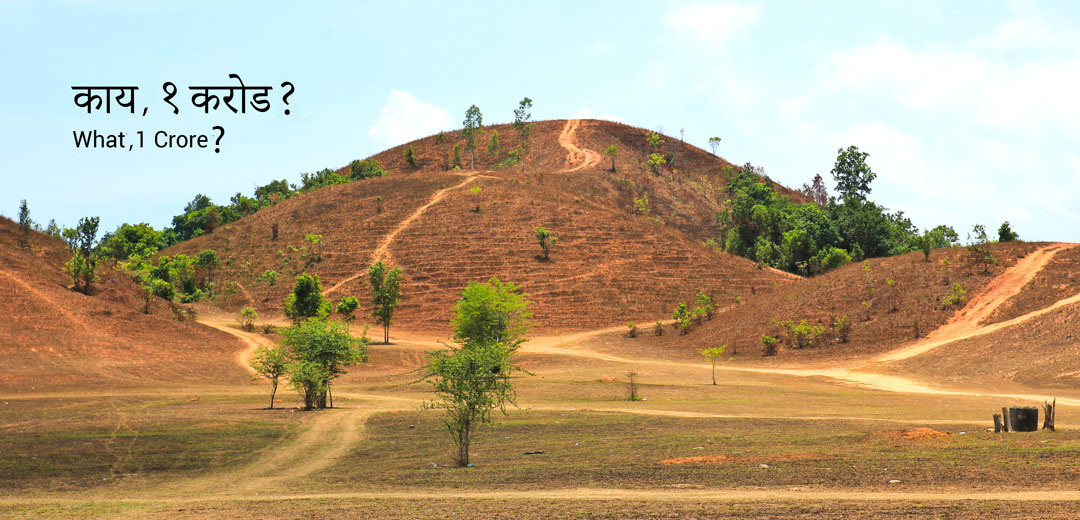अनुदिनी ६२ - Indexation / Blog 62 – Indexation
कुलकर्णी सरांनी डोळ्यावरचा चष्मा काढून बाजूला ठेवला आणि समोर टीपॅायवर पेपर घडी घालून ठेवला. वाफाळलेला चहाचा कप त्यांची वाट बघत होता. चहाचा एकेक घोट घेत असताना त्यांच्या डोक्यात विचारांचे चक्र चालू होते. तेवढ्यात पिरियड संपल्याची बेल झाली आणि ते हातात पुस्तक घेऊन क्लासरुमकडे निघते झाले पण पिरियड संपल्यावर प्रिन्सिपल परांजप्यांना भेटायचे त्यांनी निश्चित केले.
शाळेत कुलकर्णी सर हे एक विद्यार्थीप्रिय शिक्षक होते. पुस्तकी अभ्यासक्रमाव्यतीरिक्त विषय हे मुलांना कळावेत त्यांची ओळख व्हावी आणि झालीच तर त्याची आवड निर्माण व्हावी म्हणूत ते नेहमी सजग असत, जागरूक असत.
मागे ते त्यांच्या व्यक्तिगत कामासाठी अमेरिकेत गेले असताना त्यांची एका जपानी प्राध्यापकाबरोबर ओळख झाली. ती व्यक्ती बागकाम (horticulture) च्या क्षेत्रात कार्यरत होती.
तेथून आल्यावर सरांनी लगोलग मुलांकरिता ‘बोन्साय’ ह्या विषयावर एक सत्र घेतले. नुसतेच क्लासरुम लेक्चर न घेता त्यांनी एका नावाजलेल्या नर्सरीत त्यावर कार्यशाळा पण घेतली.
तर, मंडळी सांगायचं काय होतं तर नुकतेच संसदेत बजेट मंजूर झाल्याने त्यांना मुलांना त्या विषयी माहिती देण्याची कल्पना सुचली. त्यातील काही विशिष्ट संज्ञा त्यांना या वयातच समजावून सांगितल्या गेल्या तर पुढे त्याचा त्यांना नक्कीच फायदा होईल जरी ते पुढे त्या संबधित क्षेत्रात कार्यरत नसले तरी.
तर त्या प्रमाणे त्यांनी ह्या विषयातील तज्ज्ञ श्री.केळकर ह्यांचे सत्र आयोजित केले.
तास सुरु झाला,
केळकर सरांनी विषयाला सुरुवात केली,
मुलांनो तुम्ही कधी तुमच्या घरातल्या खर्चाचे आई-वडिल कसे नियोजन (planning) करतात ते समजून घेतलंय का?
सरांना अपेक्षित उत्तर मिळाले.
"आता, कुटुंबात उत्पन्नाच्या अनुषंगाने खर्च केला जातो. तो कधीच व्यस्त नसतो म्हणजे उत्पन्न कमी आणि खर्च जास्त. कारण तसे झाले तर त्या कुटुंबाचे दिवाळे वाजेल. पण देशाच्या अर्थसंकल्पात उत्पन्नापेक्षा खर्च जास्त असू शकतो. त्याचे अर्थव्यवस्थेवर परिणामही होतात. आता या अर्थसंकल्पात सरकार आपल्याला उत्पन्न कसे आणि कुठून मिळणार, किती कर्ज घेणार आणि कशाकशावर खर्च होणार हे मांडत असते.
आता आपण सरकारच्या उत्पन्न मिळवण्याच्या काही महत्वाच्या पर्यायांकडे वळू."
काय, मंडळी ही सगळी रूक्ष आणि निरस माहिती वाचून कंटाळलात का?
बरं मी तुम्हाला थोडक्यात केळकर सरांच्या या व्याख्यानातील नवीन बजेटमधील काही महत्वाच्या गोष्टी ज्याचा जास्त गवगवा झाला आहे त्या विषयी सांगतो आणि आटोपतं घेतो.
हा, तर तो मुद्दा आहे ‘Indexation Benefit’ चा आणि त्यामुळे वाढलेल्या कराचा!
त्या आधी एक गोष्ट जरा आपण समजून घेऊ.
समजा, ढोबळ मानाने आज जर ₹ १००० ला चार वस्तू मिळत असतील तर आठ-दहा वर्षांनी त्याच किंमतींत त्या दोन मिळतील. म्हणजे रूपयाची क्रयशक्ती (Purchasing power) काळाच्या ओघात महागाई मुळे कमी झाली.
बरोबर?
तर, मंडळी! समजा २०२० मध्ये आपण ₹ १० लाख कर्ज रोख्यात (Debt Fund, म्हणजे साध्या सोप्या भाषेत अत्यंत अल्प जोखीम असणाऱी बॅंकेतील ठेवी सदृश्य बाजारातील गुंतवणुक) गुंतवले आणि तीन वर्षानंतर म्हणजे २०२३ मध्ये तुम्ही ते ₹ २० लाखाला विकलेत.
तर इथे हा जो नक्त नफा ₹ १० लाख दिसत आहे त्याची क्रयशक्ती (Purchasing power) मधील काळातील भाववाढीमुळे कमी झाली.
बरोबर ना!
मग, आता ह्या पूर्ण ₹ १० लाखावर जर तुम्हाला कर भरायला सांगितला तर?
काय अस्वस्थ झालात नं?
हा, तर मागच्या आर्थिक वर्षापर्यंत सरकार ह्या सुकृत दर्शनी दिसणाऱ्या ₹ १० लाखाच्या नफ्यावर काही सवलत, सूट देत होती.
ती म्हणजे ‘Indexation!’
म्हणजे झालेल्या नफ्याला, भाववाढी समोर समायोजीत (adjust) केले जायचे आणि मग त्यावर कर आकारला जायचा.
तर, आपल्या ह्या उदाहरणात ‘Indexed Cost’, म्हणजे २०२० मध्ये विकत घेतलेल्या डेट फंडाची किंमत मधील तीन वर्षातील महागाईचा विचार करुन सूत्राच्या सहाय्याने येईल ₹ ११,५६,१४६.
मंडळी! कंटाळला नाहीत ना?
तर, हा!
आता, पुढे नफा काढताना २०२३ मध्ये ह्या गुंतवणुकीची विक्रीची किंमत जी ₹ २० लाखाची झाली त्यातून ही Index cost, ₹ ११,५६,१४६ वजा केली जात होती.
ज्याचं उत्तर ₹ ८,४३,८५४.
आणि आता ह्या नफ्यावर वीस टक्के कर आकारणी केली जात होती; ₹ १,६८,७७०.
नवीन नियमावली नुसार हा ‘Indexation’ चा मिळणारा फायदा काढून टाकला आहे, आता सरळसोटपणे विकून आलेल्या ₹ १० लाखाच्या नफ्यावर कर लावला जाईल. तो कसा?
तर आपण जर,
३०% कराच्या सीमेत येत असाल तर ₹ १० लाखावर ३०%; ₹ ३ लाख.
२०% कराच्या सीमेत येत असाल तर ₹ १० लाखावर २०%; ₹ २ लाख.
१०% कराच्या सीमेत येत असाल तर ₹ १० लाखावर १०%; ₹ १ लाख.
थोडक्यात मंडळी तुलना केली तर आपल्याला दिसून येईल की नवीन धोरणानुसार, जे १०% च्या वरच्या कराच्या सीमेत येत आहेत त्यांना आता जास्त कर भरावा लागेल की जो जुन्या नियमाप्रमाणे सर्व स्तरातील उत्पन्न असणाऱ्यांसाठी एकच होता ₹.१,६८,७७०.
तर, मंडळी! कशी काय वाटली आजची अनुदिनी?
खूपच डोक्याला ताप झाला असेल तर, उतारा म्हणून मस्त गरमा-गरम कांदाभजी आणि सोबत झक्कास कडक चहा घ्या!
काय!
Kulkarni sir removed his spectacles and set them aside. He then folded the newspaper and put it on the Tipoy in front of him. A steaming hot cup of tea was waiting for him. While sipping on the tea, he was engrossed in some thoughts. The bell rang, indicating that the class period was over, and he started towards the class with the book in his hand. He had resolved to confront the Principal, Mr. Paranjape, after class.
Kulkarni sir was a popular and loved teacher among the students. He was very particular in creating interest among the students in the subject that he used to teach by going beyond the syllabus.
He once went to America for some personal work, where he happened to meet a Japanese horticulturist professor. After returning from the USA, he had a special session for his students where he lectured them on Bonsai. He even conducted a workshop at a renowned nursery.
So, to tell you more, he had an idea of apprising his students about the recently approved budget in the parliament. He thought that if the students understood certain topics of the budget, it would certainly help them in the future, even if they did not pursue the field of commerce in higher studies or professions.
In this context, he had arranged a session with Mr. Kelkar, an expert in this subject.
When the session started, Mr. Kelkar raised the topic by asking, “Students, have you tried to understand how your parents plan the expenses?”
He got the expected answer.
Mr. Kelkar continued further,
“In a family, expenses are planned based on income. This is never skewed because if the income is less and expenses are more, then the family will go bankrupt. But in the case of a country, expenses can be more than income. This affects the economy of the nation, too. Now, how the government is planning to earn its income and how much loan it will take is what is declared in the budget.”
“Now, we will look at some important avenues from where the Govt. earns its income.”
Friends! If you are bored with learning more about this information, I will briefly discuss the important aspects of the budget.
So, let us discuss the issue of indexation benefit and the resultant increase in tax.
Before that let us understand something below.
Grossly suppose if ₹. 1000 can buy about four things today, then after 8 to 10 years, the same ₹. 1000 can buy only two things. That means the purchasing power of the Rupee has declined due to inflation.
Right?
Friends, suppose one has invested ₹. 10 Lakh in a debt fund (one of the safest investments in the market), and if it is sold for ₹. 20 Lakh after 3 years, then the value of the profit of ₹. 10 Lakh is less due to the deteriorated purchasing power of the rupee owing to inflation.
Now, if you are asked to pay tax on the amount of ₹. 10 Lakh, then you would certainly feel disturbed.
Earlier the government provided a rebate on such profit. This was called, 'Indexation.'
This means there used to be some adjustment due to inflation, and the rest amount was taxed.
So, in our example, the indexed cost ₹. 10 Lakh debt fund purchased in 2020 shall be ₹. 11,56,146 after three years due to inflation.
Hope you are still finding it interesting.
Till last year while calculating the profit after 3 years on the investment against the selling price of ₹. 20 Lakh, the index cost of ₹. 11,56,146 was deducted and the balance ₹. 8,43,854, was taxed.
Then a tax of 20% was charged on the above amount i.e. ₹. 1,68,770.
The new rule discontinued the indexation benefit, and the profit will be taxed according to the income tax slabs.
So, if you are falling under
30% tax slab, then the tax on ₹. 10 Lakh shall be ₹. 3 Lakh
20% tax slab, then the tax on ₹. 10 Lakh shall be ₹. 2 Lakh
10% tax slab, then the tax on ₹. 10 Lakh shall be ₹. 1 Lakh
In short, earlier, the tax for all slabs was the same, i.e. ₹, 1,68,770, whereas now people falling under higher slab rates shall have to pay more tax as per the tax slab.
If this has really exhausted you, then you should have a dish of piping hot fritters with a strong cup of tea!














Comments
Post a Comment